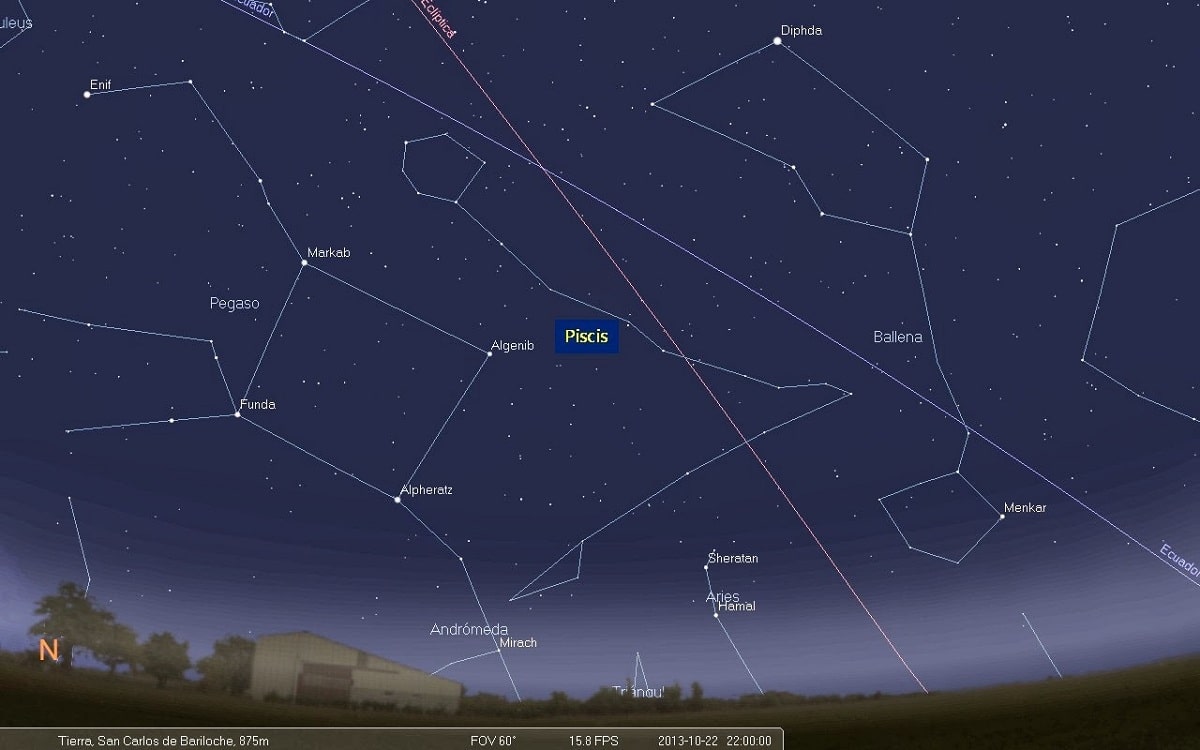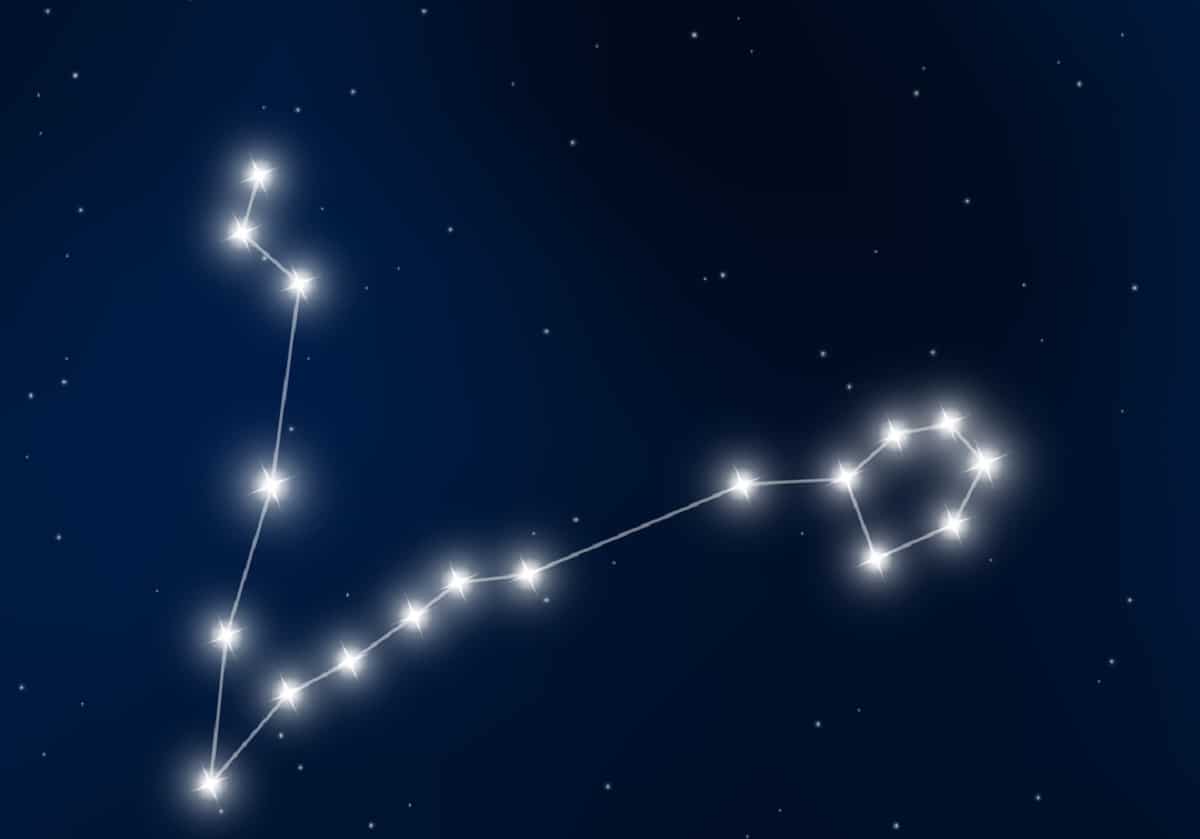
All constellations in the sky they have a meaning and an origin. Today we are going to talk about the pisces constellation which are considered the thirteenth and last of all the constellations of the zodiac. It is also known by the name of the fish that represents the flow of water. It is not a constellation that is easy to find for those who are not experts in observation. Only one of its main stars is below magnitude 4 despite being quite large.
In this article we are going to teach you all the characteristics, origin, mythology and how to recognize the constellation of Pisces.
Key features

The constellation Pisces can be seen when the elliptical and the celestial equator intersect within it. This occurs during spring and the point where they intersect is known as the vernal point or vernal equinoctial point. The main star of the constellation is α Piscium, also known by the names Alrisha or Alrischa.
It is considered one of the largest constellations within the zodiac. Despite its large size, it is not easy to observe. In urban areas where there is light pollution it becomes even more difficult to see this constellation. The brightest star has a magnitude of 3.5. Those who observe this constellation can use the constellation Pegasus to detect it. This constellation is known as the Autumn Triangle. It helps to be able to recognize the constellation of Pisces.
There are different versions of its origin, although all of them have a very common element. This origin is that it has two fish. Most accounts of the origins of this constellation come from Greek mythology and Roman mythology.
As with the constellations Aquarius and Capricorn, it is found in an area of the sky that is surrounded by other aquatic constellations. as is "the sea" or "the water." The name of this constellation comes from Latin and it means "fish." This name is obviously due to the fish-like appearance. If you look closely you can see how they look like two fish joined by a rope.
Observation of the constellation Pisces

It is a constellation that appears in the sky as one of the constellations of the zodiac. It can be seen from February 22 to March 21. This has been modified for some years now as it was based on the Babylonian calendar. This makes the current dates that this zodiac sign can be seen to be between March 12 and April 18.
If we analyze all the constellations of the zodiac that are situated in "the sea" are quite large. The vast majority of them are very dim, as is the case with this constellation. The fact that it has dim stars is one of the factors that makes it a very difficult constellation to distinguish with the naked eye. You can mainly see the autumn season from the south and spring in the north. The date we mentioned above is for the Northern Hemisphere. If you are in the southern hemisphere you have to wait for the fall season.
In order to search for it, you have to take into account some things. The first is to look for those most luminous stars that are near the main parts of the same. That is, the two main stars that shine the most are those of the fish's head and the one of the rope. In order for you to find the fish that swims north, you have to look for the constellation of Pegasus first, as it is easier. This constellation is located to the south of this. We can find it about the star Markab. In this way, we will analyze the head that goes south and is close to the constellation Andromeda. The string is the binary star Alrisha which is the brightest and easiest to recognize.
It mainly features two deep sky objects. These two objects are the spiral galaxy M74, and NGC 520 formed by two colliding galaxies. Regarding all the stars and bordering constellations with the constellation of Pisces we can see the following: to the west is the constellation of Aries, being the first constellation of the zodiac. To the north we have the constellation Pegasus, Andromeda and the triangle. Finally, to the south we find the constellation of Cetus.
Pisces constellation mythology

Greek mythology is what has given rise to this type of constellation. It is known as the Pisces myth. It should also be mentioned that Roman culture has had to do with the origin and meaning of this myth. There are some very symbolic peculiarities of the Babylonian culture since this It is one of the first 44 constellations that are represented in this culture.
There is the myth of Eratosthenes that says that the origin of Pisces was the goddess Derceto. Derceto was the daughter of Aphrodite. It is supposed to be a mermaid or the closest thing to it since it was composed of a woman half from the waist up and half from the waist down. The main difference with the mermaids that we have today in mythology is that it had two legs.
This myth said that one night Derceto was around a lagoon and fell into the water. Although they had the body of a mermaid, they could not swim and could not get out of the water by herself. A large fish was able to rescue her and this is where the origin of the Pisces symbol is born. It is about two beings united at the moment of rescue. It is possible that this image does not look good in the constellation Pisces, since it is thought that Pérez himself who saved the life was the one that gave rise to his own constellation.
Main stars
Finally we are going to list which are the main stars of this constellation. We have already mentioned that they are Alrisha or Alrischa (α Piscium) and Fum al Samaka (β Piscium). However, although there are other less bright stars, they are also important. The brightest is Kullat Nunu. The name Alrisha comes from the Arabic and means the rope. The name well indicated by its position in the constellation and is the one that indicates the knot between both strings in particular.
I hope that with this information you can learn more about the constellation Pisces.